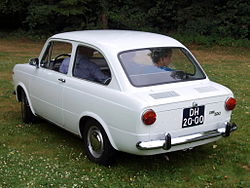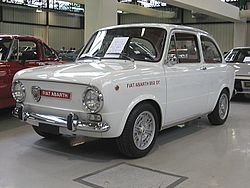Overview
Its technical design was an evolution of the successful Fiat 600, as the 850 was originally thought to be its successor. This, however, did not materialize, as the 600 remained in production during almost all of the 850's lifespan, which also was a larger and more expensive car. [1] The internal name for the Fiat 600 development project was "Project 100" and consequently, the internal Fiat codename for the 850 project was 100G (G was a follow on of model designations for the 600 which ran from A to F). The engine of the 850 was based on that of the Fiat 600, but had its capacity increased to 843 cc. The 850 came in two versions: "normale" (standard) with 34 hp (25 kW) and engine code 100G.000 and "super" with 37 hp (27 kW) and engine code 100G.002. The maximum speed was approximately 125 km/h (78 mph). While it was not a large step forward in technical development, it possessed a certain charm with its large rolling eyes and its short tail, in which the engine sat.
Variants
The 850 family included several body styles sharing core technical components:
- Fiat 850 Special — Revised version of the 850 sedan, launched in 1968. It shared the 47 hp (35 kW) engine of the 850 Coupé, and offered front disc brakes, sport steering wheel and improved trim. With a 25 percent increase in power, plus disc brakes nestled behind 13" wheels, it was a "sports sedan" on a smaller scale. Engine code 100GB.000.
- Fiat 850 Familiare — The Familiare was a boxier and slightly larger successor to the Fiat 600 Multipla with a significantly squared-off rear featuring a rear hatch which made it a true van. It featured space for seven passengers in three rows, suitable for groups including children and thin adults, but is too small to accommodate seven typical adults in comfort.
- The 850 Familiare continued in production till 1976 long after the saloon version of the 850 had been replaced by the Fiat 127. In 1976 the Fiat 900T was introduced, retaining most of the body panels of the 850 Familiare, but featuring the 903 cc engine from the Fiat 127 (although, in this application, still mounted behind the rear axle): the 900T benefited from significant enhancements in 1980, being now renamed 900E. At least in the UK the 900 series camper vans were badged as FIAT Amigo. Production stopped in 1985.
- Fiat 850 Coupé — The Coupé was introduced in 1965 at the Geneva Motor Show and had the original 843 cc (51 cu in) engine producing 47 hp (35 kW). The maximum speed at that time was 135 km/h (84 mph). Engine code 100GC.000.
- Fiat 850 Spider — At the same time as the Coupé, Fiat also introduced the convertible sporty two-seater Spider, with the original 843 cc engine tuned to produce 49 hp (36 kW) which allowed it to reach a top speed of 145 km/h (90 mph). The body was designed and built by Bertone in its Grugliasco, Turin plant. [11] The folding fabric roof stowed under a rear metal body panel. The Bertone design featured smooth, simple lines and details, including recessed headlamps equipped with plexiglass covers angled to match the adjacent fenders/wings — and dihedral side panels similar to Bertone's 1963 Chevrolet Testudo. The Spider's engine code was 100GS.000.
At the time of their introduction into the United States the Sedan, Coupé and Spider were marketed with a reduced capacity, high compression 817 cc (50 cu in) engine in order to beat US emissions regulations at the time which applied only to engines equal to or larger than 50 cubic inches. Compression was raised from 8.8:1 to 9.2:1, requiring premium octane fuel.
In order to separate the sportier variants Coupé and Spider from the basic version, apart from the increase of engine performance, the equipment was also extended and adapted to the higher expectations. Both received sport seats, a sport steering wheel and round speedometer; the Spider even received a completely rearranged instrument panel. The front drum brakes were replaced with disc brakes, although drum brakes remained on the rear wheels.
In 1968, Fiat revised the successful Spider and Coupé again and gave them an even stronger engine with 903 cc and 52 hp (38 kW). They were called Sport Spider (engine code 100GBS.000) and Sport Coupé (engine code 100GBC.000). The Sport Spider body stayed essentially the same, but with a restyled front. The headlamps were moved forward slightly and the glass covers were eliminated giving the car a "frog-eye" look, and the original flush front turn indicators were replaced with units hung below the bumper. Several limited special edition versions of the Spider were offered, including the Racer featuring a body-colored metal hard top and the Racer Berlinetta featuring a black vinyl hard top.
There was a minivan and transporter model as a successor of the world's first minivan, Fiat 600 Multipla , which was later renamed to 900T and likewise received the larger capacity of 903 cc. The 850 Super was also license-built by NSU-Fiat in Heilbronn, Germany, who sold it as the "Neckar Adria." In 1968, NSU-Fiat changed to the more powerful 850 Special. Between June 1965 and September 1969, 6,619 Adrias were assembled in Germany. The establishment of the European Economic Community had gradually decreased Germany's protective tariffs, from 90 percent in 1957 to none at all from July 1968, and thus there was no longer any reason to assemble Fiats in Heilbronn.
Production of the Coupés and sedan ended in 1971, [1] and of the Spiders in 1973, after altogether nearly 2.3 million models were sold worldwide, 140,000 of which were Spiders. [11] Under the name SEAT 850, it was however further produced for some years in Spain, also in a four-door variant. As a successor the Fiat 127 was brought to the market in 1971 which combined the 903 cc push-rod OHV engine with the FIAT 128 transmission and suspension components in a fashionable fast- and later hatch-back 2-door sedan.
Between 1978 and 1983, the U.S. government issued a highly unusual recall for the Fiat 850—going back 10 years—for rust problems. [12]
In 1967, Road & Track called the Fiat 850 coupé "one of the handsomest, best-balanced designs ever seen on a small car". [12]
Consumer Reports disliked their 1968 Fiat 850, finding it noisy and sluggish, with poor ride and handling. [13]
1965 Fiat 850 Sedan
1966 Neckar Adria; this car mainly differed in terms of badging
Fiat 850 Coupé, series I
Fiat 850 Coupé, series II
Fiat 850 Coupé interior
Fiat 850 Spider
Fiat 850 Racer Berlinetta
Fiat 850 Familiare
Fiat 850T


















